Jupiter photos
with CCD web camera:

Click the
image to see full size animation (0.32"/pixel). |
Jupiter and
Io. 26.1.2003, 03:00 - 03:34 (02:00 - 02:34 UT)
Resolution: 0.48 arcsec/pixel
Telescope: 8" OrionOptics Newtonian (f=1200mm)
Camera: Vesta 675SC2 + Barlow 3X
Result focal length: 3600mm
Exposure: 97x1/50s (gain 50%)
Seeing: turbulence, 1°C
Processing: K3CCDTools
+ Maxim DL Demo + Corel PhotoPaint
This is animation of 4 photos taken during half
an hour. Notice movement of Io. |
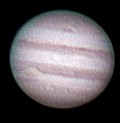 |
Jupiter. 26.1.2003, 03:20
(02:20 UT)
Resolution: 0.48 arcsec/pixel
Telescope: 8" OrionOptics Newtonian (f=1200mm)
Camera: Vesta 675SC2 + Barlow 3X
Result focal length: 3600mm
Exposure: 97x1/50s (gain 50%)
Seeing: turbulence, 1°C
Processing: K3CCDTools
+ Corel PhotoPaint
The first try of Jupiter photo with my 3X Barlow
lens. Rather bad seeing didn't allow me to
capture more details. I switched motor drive off
to suppress vibrations during capturing.
It is interesting to see the changes in Jupiter's
atmosphere during last year - the thin band in
the North hemisphere (visible year ago) is not
visible now.Processing:
1. Stacked in K3CCDTools
2. Gamma 0.8, histogram adjustment in K3CCDTools
3. Unsharp mask in K3CCDTools (4, 0, 300)
4. Resized to 66% in Corel PhotoPaint, unsharp
mask (in green color plate)
5. Color saturation enhancement in Corel
PhotoPaint
Look here at AVI sample of
best 25 frames of Jupiter.
Look also at comparison
of processing results of K3CCDTools and Registax.
|
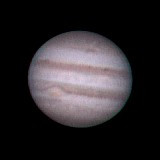
Click the
image to see full size image (0.32"/pixel). |
Jupiter. 26.1.2003,
03:34 (02:34 UT)
Resolution: 0.48 arcsec/pixel
Telescope: 8" OrionOptics Newtonian (f=1200mm)
Camera: Vesta 675SC2 + Barlow 3X
Result focal length: 3600mm
Exposure: 400x1/50s (gain 50%)
Seeing: turbulence, 1°C
Processing: K3CCDTools
+ Maxim DL Demo + Corel PhotoPaint
A few minutes later... Stacked 400 frames in X2
mode in K3CCDTools. The motor drive was switched
on. Stacking more frames than in the above case
results in less noise, but also less details are
visible.Processing:
1. Stacked 400 frames in K3CCDTools (X2 mode)
2. Gamma 0.8, histogram adjustment in K3CCDTools
3. Unsharp mask in K3CCDTools (8, 0, 450)
4. Resized to 50% in Corel PhotoPaint
5. Realigning color planes and enhanced color
saturation (150%) in Maxim DL Demo
6. Resized to 66% in Corel PhotoPaint
7. Unsharp mask (1, 0, 100) in K3CCDTools
|
Jupiter
rotation + Io eclipse. 8.3.2002, 22:36-23:47 (8.3.2002,
22:36-23:47 UT)
 In the second
picture, the shadow of Io is just touching the
left side of Jupiter's disk.
In the fifth picture, Io is just leaving
Jupiter's disk.
The transit of Io in front of Jupiter's disk is
not visible (low contrast).
Compare with Starry Night Backyard simulation
(it is visible, that real phenomenon ran about 2
minutes ahead):

|
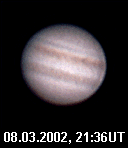 |
Resolution:
0.96 arcsec/pixel
Telescope: 8" OrionOptics Newtonian (f=1200mm)
Camera: Vesta 675SC + Barlow 2X
Result focal length: 2400mm
Exposure: each image about 150x1/25s (gain 20%)
Seeing: average seeing for my location
Processing: K3CCDTools + MaximDL Demo (Color
planes aligning) + Corel PhotoPaint
Color planes aligning (MaximDL Demo) was used to
suppress atmospheric refraction |
Jupiter
rotation. 8.2.2002, 23:05-23:41 (8.2.2002, 22:05-22:41
UT)
 |
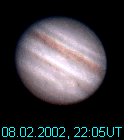 |
Resolution:
0.96 arcsec/pixel
Telescope: 8" OrionOptics Newtonian (f=1200mm)
Camera: Vesta 675SC + Barlow 2X
Result focal length: 2400mm
Exposure: each image about 250x1/25s (gain 20%)
Seeing: average seeing for my location
Processing: K3CCDTools + Corel PhotoPaint
Hartman mask was used for focusing (focused on
Jupiter's moons). |
Jupiter
and moons. 26.1.2002, 00:46 (25.1.2002, 23:46 UT)

Move mouse
pointer above picture to see labels |
Resolution: 0.96
arcsec/pixel
Telescope: 8" OrionOptics Newtonian (f=1200mm)
Camera: Vesta 675SC + Barlow 2X
Result focal length: 2400mm
Exposure: 307x1/50s (gain 40%)
Seeing: relative good seeing for my location
Processing: K3CCDTools + Corel PhotoPaintCentral meridian longitudes:
System I: 251.5°
System II: 223.6°
|
This photo is not a
composition of multiply images nor mosaic, it is
one exposure settings. I set exposure level in K3CCDTools
to level, in which Jupiter disk was not
saturated, but moons were visible.
UM 10, 0, 100%
Gamma 0.80
UM 8, 0, 100%
Rotation 27°
UM 1, 1, 100%
Resize 50%
Gamma 0.80
UM 4,0,100%
Gamma 0.85
UM 2,2,100% |
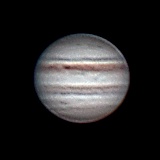 |
Jupiter.
26.1.2002, 00:40 (25.1.2002, 23:40 UT)
Resolution: 0.96 arcsec/pixel
Telescope: 8" OrionOptics Newtonian (f=1200mm)
Camera: Vesta 675SC + Barlow 2X
Result focal length: 2400mm
Exposure: 214x1/50s (gain 40%)
Seeing: relative good seeing for my location
Processing: K3CCDTools + Corel PhotoPaint
Central meridian longitudes:
System I: 247.9°
System II: 219.9°
This was the first clear night after 3 weeks! The
evening looked promissing, but when my telescope
was cooled down, huge clouds appeared. I wanted
to give up the imaging session, but I beheld
Jupiter by naked eye through the clouds. As I
didn't watch the sky for 3 weeks, I wanted to see
Jupiter notwithstanding that clouds. I noticed,
that Jupiter image in telescope was much more
stable than in my previous observing sessions. So
I decided to get some photo through the clouds.
After focusing the image I found out, that clouds
were going away, so I waited a little bit. And
result is here!
More about
Jupiter and seeing conditions |
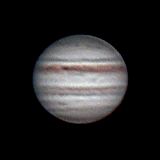 |
Jupiter. 26.1.2002, 00:40
- 00:46(25.1.2002, 23:40 - 23:46 UT)
Animation from the two above photos. Rotation of
Jupiter during 6 minutes is evident. |
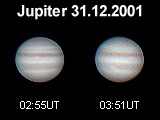
Move mouse
pointer above picture to see labels |
Jupiter's
rotation, 31.12.2001, 03:55-04:51 (02:55-03:51UT)
Resolution: 0.96 arcsec/pixel
Telescope: 8" OrionOptics Newtonian (f=1200mm)
Camera: Vesta 675SC + Barlow 2X
Result focal length: 2400mm
Jupiter's rotation durimg about 1 hour. |
 Click
the image to see full size image (0.48"/pixel).
|
Jupiter. 31.12.2001, 04:51
(03:51 UT)
Resolution: 0.96 arcsec/pixel
Telescope: 8" OrionOptics Newtonian (f=1200mm)
Camera: Vesta 675SC + Barlow 2X
Result focal length: 2400mm
Exposure: 307x1/50s (gain 20%)
Seeing: big air turbulence - poor conditions
Processing: K3CCDTools + Corel PhotoPaintThe same night as below, about 1
hour later, but conditions went off, GRS is near
center.
|
 Click
the image to see full size image (0.48"/pixel).
|
Jupiter. 31.12.2001, 03:55
(02:55 UT)
Resolution: 0.96 arcsec/pixel
Telescope: 8" OrionOptics Newtonian (f=1200mm)
Camera: Vesta 675SC + Barlow 2X
Result focal length: 2400mm
Exposure: 190x1/50s (gain 20%)
Seeing: big air turbulence
Processing: K3CCDTools + Corel PhotoPaintGRS is appearing in the left side.
|

Click the
image to see full size image (0.48"/pixel).
|
Jupiter. 28.12.2001, 02:27
(01:27 UT)
Resolution: 0.96 arcsec/pixel
Telescope: 8" OrionOptics Newtonian (f=1200mm)
Camera: Vesta 675SC + Barlow 2X
Result focal length: 2400mm
Exposure: 139x1/33s (gain 20%)
Seeing: big air turbulence
Processing: K3CCDTools + Corel PhotoPaint
The motor drive was turned off while capturing
AVI file. |

|
Jupiter. 23.12.2000, 00:07
(22.12.2000, 23:07 UTC)
Web camera at focus of 150mm (f=1000mm) Newtonian
telescope
|
 |
Jupiter with family. 28.11.2000,
01:27 (00:27 UTC)
Web camera at focus of 76mm (f=700mm) Newtonian (Bushnell)
telescope
Click
the image to see full size image. |
Back to
Solar System Page
Computer generated images,
real images, drawings and texts are property of the
author and may not be reproduced or used without
permission of author.

Last Update:
03.02.2002
|